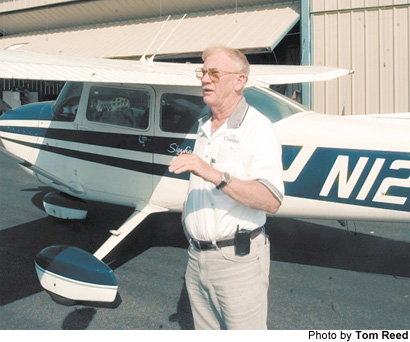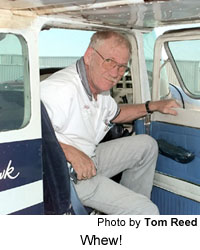
September 19, 2000 — I learned how to fly an airplane last week. Landed the thing three times. But — odd as it may seem — the most awkward moments of my lesson occurred while I was on the ground.
Who knew taxiing an airplane around the tarmac could be so difficult, so counterintuitive? Who knew that, while on the ground, you steer an airplane with your feet?
Habit tells you to grab the control wheel and turn it right or left. Habit, I imagine, has guided a few rookie pilots off the runway over the years.
Not me, though. No, I had instructor John Davis in the co-pilot’s seat. And it’s in his best interest to make sure stuff like that doesn’t happen.
So, with my feet working the rudder pedals and my hands feeling helpless, I weaved Davis’ Cessna 172 Skyhawk single-propeller plane down runway 22 of Lee Gilmer Memorial Airport. Once we hit 60 mph, I pulled back on the control wheel — with my hands … finally — and we headed for the sky.
Just like that. In the air, everything seemed easy, somehow natural. We can thank Mr. Bernoulli and his principle of lift for that.
The prep work for this lesson took place hours earlier, back in hangar J6. That’s when Davis, with the rumble of small-engine planes taking off and landing in the distance, gave me a “sixth-grade class” on aerodynamics using a hand-held foam airplane.
He spoke of formulas and principles, angles and degrees. But, simply put, these things are designed to go up. And, when you want them to, they are designed to go down.
We headed to the plane. Davis did a safety walk-around of the Cessna to make sure everything was in order. The blue-and-white four-seater that we flew was a 1974 model. A bit old, you may think. But not in plane years. Davis’ personal craft was built in 1948, 11 years before he took up flying.
A short stint in the Air Force led to a 35-year career as a major airline pilot. He retired three years ago — only because retirement at age 60 is mandatory for pilots. He’s been teaching people how to fly out of hangar J6 ever since.
“You ready?” Davis asked. 
Good question. I wasn’t quite certain. But since Davis seemed prepared to fly with me, I responded, “sure.”
Strapped inside the tiny plane, I was overwhelmed by the size and apparent complexity of its instrument panel. Dozens of dials and gauges sat before me — and, one by one, Davis described how each item was specifically designed to keep me from turning the plane into a spiraling ball of fire.
Noticing a red button on my control wheel, I interrupted, “Is this the eject button?”
“Well, no … ,” Davis chuckled. (If you were wondering, the red button controls the radio transmitter — there are no ejection seats.)
His safety checklist complete and his student completely anxious, Davis was primed for the airborne portion of the lesson.
“Um, you might want to put your notepad away now. You’re going to be busy up there,” Davis said. I obliged.
“All right, let’s crank this thing up. Clear, prop!”
We put on our headsets. I turned the key and pushed in the throttle. I took my hands off the control wheel, and steered the plane toward the runway.
“Cessna one two eighty-four zero is departing runway two two at Gainesville,” Davis announced into his radio.
And we were off.
“It’s the freedom. It’s like an escape from reality.” That’s how local Realtor Kim Waters described the act of flying to me. It was Waters who put me in touch with Davis. It was Davis who introduced Waters to flying in early 1999.
Waters has since purchased a plane. She now spends most of her free time either at the airport or in the air.
“It means more to me than anything I’ve ever done,” she said. “It’s just the love of my life.”
There are others like Waters at the airport. Davis and three other instructors have helped some 20 new pilots earn their licenses over the past two years. Several have gone on to buy planes, making Gainesville a relatively busy little airfield.
Amid the business commuters and pleasure pilots, there are corporate jets. Daily flights drop off cancelled checks, and others pick up shipments of baby chicks.
All of that got smaller, became rather insignificant, in fact, as Davis and I flew higher and higher. I was in control up there. And as long as I did whatever Davis suggested, it was somewhat of a smooth ride.
A hazy sky made visibility poorer than normal, I was told. We could see as far as Wauka Mountain in Clermont, but I was more interested in what lie immediately before us — Gainesville.
Look, there’s The Times building. Over there, that’s my house.
But, as pilot, I wasn’t up there to sightsee. Our nose began to dip as I peered out the side window. That’s not supposed to happen.
Davis directed me through a series of turns and patterns, and at some point during the lesson, I lost track of time. It didn’t really seem to matter up there. All I know is that when Davis told me to head back to the airport, it seemed too soon.
He made things simple for me on the approach. “Make a left at the Cargill plant,” he said.
I believe this is when I began to sweat, to grip the wheel a little tighter. The runway was getting closer and closer, and I was behind the wheel.
Davis helped, of course. He pulled out the throttle and lowered the flaps to slow us down, and did other things that helped “take adverse pressures” off of me. He also told me exactly what to do.
We lost more speed. The runway became bigger. And, all of a sudden, it happened. Somehow, softly, we had landed. Simple as that. No ball of fire.
Then we sped back up and took off again.
My second landing, in Davis’ words, “wasn’t that good.” The third — the one on which he provided the least help — was “within reason.”
I’m not sure if he would say the same about my foot steering on the way back to the hangar.
